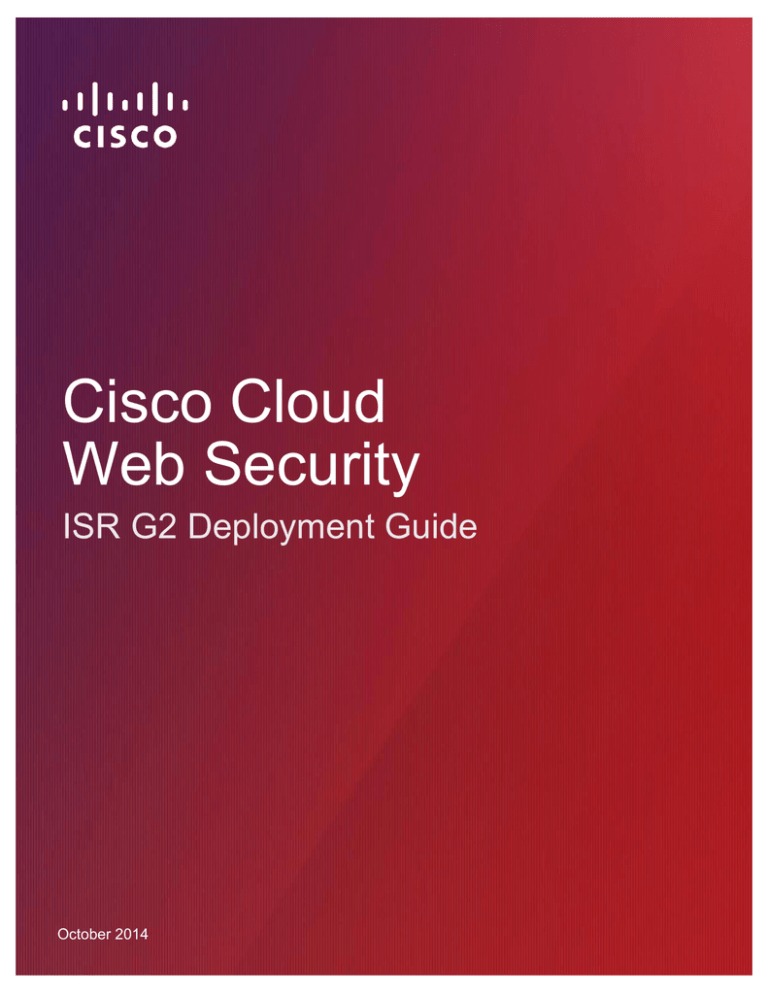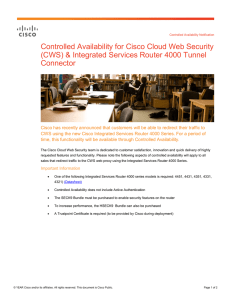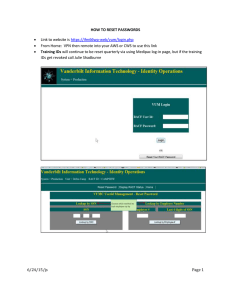Cisco Cloud Web Security ISR G2 Deployment Guide October 2014
advertisement

Cisco Cloud Web Security ISR G2 Deployment Guide October 2014 1 Cisco CWS - ISR G2 Deployment Guide Contents Introduction.................................................................................................................................................... 1 Cloud Deployment ..................................................................................................................................... 1 Additional Redirect Methods ..................................................................................................................... 1 Prepare.......................................................................................................................................................... 2 Verify proper IOS image ............................................................................................................................ 2 Verify connection to a tower ...................................................................................................................... 2 Create authentication license key ............................................................................................................. 3 Deploy ........................................................................................................................................................... 5 Configure an ISR G2 connection .............................................................................................................. 5 Redirect web traffic ................................................................................................................................ 5 Configure ACL whitelisting – By Host .................................................................................................... 5 Configure ACL whitelisting – By User Agent ......................................................................................... 5 Configure user identity ........................................................................................................................... 6 Test ............................................................................................................................................................... 7 Verify web redirection to the cloud ............................................................................................................ 7 i Cisco CWS - ISR G2 Deployment Guide Introduction Integrating CWS with the ISR G2 appliance saves bandwidth, money and resources by intelligently redirecting internet traffic from branch offices directly to the cloud to enforce security and control policies. This document provides directions to redirect network traffic to CWS through the ISR G2. *Note: we refer to our cloud proxies as towers. You will see the terms “proxy” and “tower” used interchangeably throughout the document. Cloud Deployment Deployment is divided into the following three sections Prepare Deploy Test Additional Redirect Methods There are 4 additional redirection methods that have corresponding deployment guides. Deployment guides for each redirection methods can be found here, under Technical Collateral. Redirection Method Overview Next Generation Firewall (ASA/ASAv with CWS Connector) Capitalize ASA investments by offloading content scanning to Cisco’s cloud through CWS. Apply acceptable use policy to the company, groups or individual users. Web Security Appliance (WSA/WSAv with CWS Connector) Integrate CWS and WSA to enable identity information to the cloud and extend other on-premises enterprise features to Cloud Web Security customers Cisco AnyConnect Secure Mobility Client (AnyConnect) Authenticate and redirect web traffic securely whenever the end user is off the corporate network. CWS leverages cached user credentials and directory information when they are away from the office or VPN, ensuring that exactly the same web-usage policies are applied. Standalone Deployment Deploy a simple web security solution that does not require any additional hardware. Connect to Cisco’s Cloud Web Security service using existing browser settings and PAC/WPAD files. 1 Cisco CWS - ISR G2 Deployment Guide Prepare Deploy Test Prepare Verify proper IOS image The recommended version at the time of this writing is 15.3.3M3 or later. However, CWS is supported is IOS version 15.2(1) T1 and later. For up-to-date information, please reference this link: https://supportforums.cisco.com/document/12110031/cisco-cloud-web-security-cws-isr-g2-faq *Note: For images earlier than 15.3.3M3, all references to “cws” in the CLI please use “content-scan” instead. Verify connection to a tower Site-to-tower communication is accomplished over TCP port 8080. HTTP and HTTPS requests are sent to a cloud scanning tower in this method. Therefore, TCP port 8080 outbound is required to be open for all users within the organization. For security reasons, Cisco recommends that port 8080 outbound destinations be limited to the scanning towers provisioned for the customer’s account. Reference video: Verify connection to a tower Step 1: Log on to a client computer inside the customer’s network. Step 2: Click on the Control Panel and go to Programs and Features. Step 3: Click Turn on Windows features on or off. Scroll down the list of available features until you find the Telnet Client. Check the box and click OK. Now that the Telnet Client is installed, we can resume our test. Figure 1.1 Step 4: Open the command line window and type command ‘telnet [tower IP address] 8080.” A successful connection is noted by a blank screen and blinking cursor. Figure 1.2 2 Cisco CWS - ISR G2 Deployment Guide Prepare Deploy Test Create authentication license key Reference video: Authentication license key creation and management Step 1: Log on to the Cisco Cloud Web Security portal at https://scancenter.scansafe.com/. Step 2: From the Admin tab, mouse over Authentication, and select the key that you would like to generate. The options are Company Key to have a single key for all users in the company (can be used in various Connectors), AnyConnect, or a mixture of them all. Step 3: Notice that no Company Key currently exists in this account. Click the Create Key button to create the Company Key. If one already exists and you don’t know the whole string (only the last four characters will be seen), then you will have to revoke it before you can create a new one, but then if it is in use anywhere (Connectors or AnyConnect) then it will have to be replaced with the new one Step 4: The key is active immediately. The email option below is only for the admin to have a backup of the key. Note: Once you navigate away from the page you’ll no longer see the complete string of the key (only the last 4 characters). Figure 1.3 Step 5: Copy the entire alphanumeric string in the Authentication Key field and record it in a document that will be backed up. *Note: The second option is to create a group key by selecting Group Key under Authentication. To create a group key you may either use an existing directory group or you may create a custom group under Admin Management Groups. Step 6: Click on the Create Key button which corresponds to the group for which you are creating a key. 3 Cisco CWS - ISR G2 Deployment Guide Prepare Deploy Test Figure 1.4 *Note: It is the same UI and process for creating a Company Key 4 Cisco CWS - ISR G2 Deployment Guide Prepare Deploy Test Deploy Configure an ISR G2 connection This document is intended to provide an overview of the deployment process. For more detailed information and troubleshooting, please refer to the Admin Guide. Cisco ISR-G2 routers enables you to easily connect branch office networks to CWS. Connector functionality integrated into the ISR G2 device software intelligently redirects web traffic to CWS to enforce security and control policies. With this integrated routing and web security solution, branch offices can be controlled centrally. ISR G2 routers also serve as a cost-effective solution for delivering CWS on public WiFi networks. Redirect web traffic parameter-map type content-scan global server scansafe primary ipv4 <primary tower ip> port http 8080 https 8080 server scansafe secondary ipv4 <secondary tower ip> port http 8080 https 8080 license 0 <license key generated above> source interface GigabitEthernet0/1 timeout server 30 server scansafe on-failure block-all interface GigabitEthernet0/1 cws out Note the following: license - this is where you apply the license key you generated above. Using 0 will be in clear text, using 7 will be encrypted source interface- this command configures an interface or an IP address as the source from which packets to Cloud Web Security will originate from the device. The IP address that is configured in this command must be the IP addresses that is associated with the interface on which “cws out” command is configured. cws out- this command enables web filtering and should be applied to the outside interface. Configure ACL whitelisting – By Host parameter-map type regex allowed_hosts pattern *.cisco.com cws whitelisting whitelist header host regex allowed_hosts Configure ACL whitelisting – By User Agent parameter-map type regex allowed_user-agents pattern Mozilla/5.0 cws whitelisting 5 Cisco CWS - ISR G2 Deployment Guide Prepare Deploy Test whitelist header user-agent regex allowed_user-agents Configuring LDAP Server aaa new-model aaa group server ldap scansafe server ss-ldap ldap server ss-ldap ipv4 <ldap server ip> transport port 3268 bind authenticate root-dn "<service account distinguished name>" password <server account password> base-dn "<search base distinguished name>" search-filter user-object-type user authentication bind-first Configure user identity aaa authentication login ss-aaa group scansafe aaa authorization network ss-aaa group scansafe aaa accounting network ss-aaa none ip admission virtual-ip 1.1.1.1 virtual-host proxy ip admission name ssauth ntlm passive inactivity-time 60 ip admission name ssauth order ntlm ip admission name ssauth method-list authentication ss-aaa authorization ssaaa accounting ss-aaa interface GigabitEthernet0/0 ip admission ssauth ip http server aaa authentication login default none aaa authorization exec default none For user authentication to work, the client must be able to resolve "proxy" to the IP address 1.1.1.1. For testing purposes, edit the hosts file on a client to include an entry for this IP address. In production, create an A record in DNS. Troubleshooting commands sh cws statistics sh cws summary sh cws session active sh cws session history <1-512> Bypass ip admission (auth) ip admission name ntlm-rule ntlm list ssauth ip access-list extended ssauth permit ip <corporate ip> <wildcard mask> any any Bypass HTTPS filtering: ip access-list extended matchHTTPS permit ip any any eq 443 cws whitelisting whitelist acl name matchHTTPS 6 CWS Deployment Guide - ISR G2 Appliance Prepare Deploy Test Test Verify web redirection to the cloud Step 1: From a client machine, browse to whoami.scansafe.net. If a message is displayed, “User is not currently using the service,” then the traffic is not redirected to the Cisco cloud. This can be useful in determining if the user is being resolved correctly, any groups being discovered, the internal/external IP of the user/location, and what Connector is in use. This is an example of a successful whoami.scansafe.net output: authUserName: "WinNT://CISCO\\user" authenticated: true companyName: Cisco connectorGuid: ABC012345AB connectorVersion: "AP-ISR-x.x(x)x," countryCode: US externalIp: 12.34.56.78 groupNames: - "LDAP://Group" internalIp: 1.2.3.4 logicalTowerNumber: 1782 staticGroupNames: - "LDAP://Group" userName: "WinNT://CISCO\\user" Step 2: From a client machine, browse to policytrace.scansafe.net and enter a URL to see how the web request is processed against the current web filtering policy. Step 3: With SearchAhead enabled in ScanCenter (the CWS admin portal), browse to Google, Bing, or Yahoo and search for something. The SearchAhead data should be prepended to each search result in the form of a green, yellow, or red dot. Mouse over the dot to see what information is contained within. *Note: For additional options on authentication methods reference this link. Americas Headquarters Cisco Systems, Inc. San Jose, CA Asia Pacific Headquarters Cisco Systems (USA) Pte. Ltd. Singapore Europe Headquarters Cisco Systems International BV Amsterdam The Netherlands Cisco has more than 200 offices worldwide. Addresses, phone numbers, and fax numbers are listed on the Cisco Website at www.cisco.com/go/offices. Cisco and the Cisco logo are trademarks or registered trademarks of Cisco and/or its affiliates in the U.S. and other countries. To view a list of Cisco trademarks. Go to this URL: www.cisco.com/go/trademarks. Third party trademarks mentioned are the property of their respective owners. The use of the word partner does not imply a partnership relationship between Cisco and any other company. (1 1 1OR) Printed in USA C11-727200-00 04/13 7


